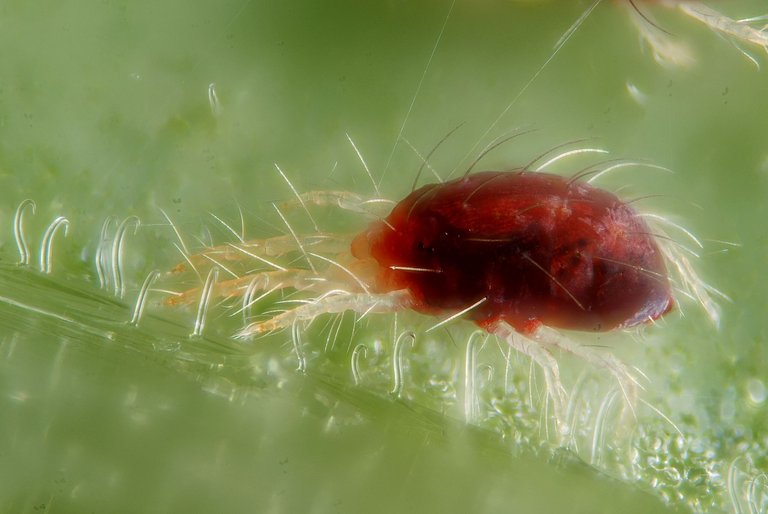Hello everyone and welcome back to my Blog!
Today I’m talking about a parasite that, unfortunately, very often hosts our plants in this particular period of the year. What are we talking about? How to fight it? Let's find out together in this post.
The red spider, scientific name Tetranychus urticae, is a mite that feeds on the cytoplasm of plant cells causing serious damage if left to act uncontested.
During just one year it can reproduce forming from 8 to 10 generations and this makes it particularly prolific and difficult to contrast with a pesticide that acts only on adult forms. For this reason, it is necessary to act with products of different nature in order to intervene both on the juvenile forms and on the adults, moreover there are particularly effective products on the eggs of this insidious pest.

By Gilles San Martin - originally posted to Flickr as Tetranychus urticae with silk threads, CC BY-SA 2.0, https://commons.wikimedia.org/w/index.php?curid=11208762
At an industrial and productive level, the search for remedies is particularly felt in the cultivation of soy, an economically valuable plant but extremely sensitive to the bites of this mite. Other plants that are particularly affected by this great enemy are carnivorous plants. In fact, Dionaea muscipula, perhaps the carnivorous plant par excellence, is very sensitive to this parasite.
How do I recognize Tetranychus urticae? In late spring or early summer, a progressive deterioration of the plant is observed with drying of the bronze-colored leaves. A typical sign of red spider mite attacks are also small cobwebs on the edge of the leaves, visible with good lighting and abundant nebulization.
Can the spider mite be seen with the naked eye? The common name of this mite creates a lot of confusion! In fact, think that the red spider in most cases is not red in color, does not have 8 legs like spiders and can only be seen with a microscope!
How to fight the red spider? Obviously, mechanical removal and natural products are always preferable to the use of chemicals. Nevertheless, sometimes, in the case of extensive parasites, a combination of plant protection products is required, one that acts on adults and a product that acts on the juvenile forms and on the eggs laid by adults. In Italy, for example, the products approved by the Ministry of Health are called Fazilo and Acetamiprid. Unfortunately, spider mites cannot be prevented, but the combined use of these products can eliminate this parasite from our plants. The only remedy devoid of chemical active ingredients that has proved effective is mineral oil, but very frequent treatments must be carried out, given its lack of specificity for young forms.

Photo by Mariana Lazaro mari_lazaro from Pixabay
Thanks for reading and greetings to all plant lovers!
See you next time,
Delilha

ITA
Buongiorno a tutti e bentornati sul mio Blog!
Oggi vi parlo di un parassita che, purtroppo, molto spesso ospita le nostre piante in questo particolare periodo dell’anno. Di cosa si tratta? Come combatterlo? Lo scopriamo insieme in questo post.
Il ragnetto rosso, nome scientifico Tetranychus urticae, è un acaro che si nutre del citoplasma delle cellule vegetali apportando gravi danni se lasciato agire in maniera incontrastata.
Nel corso di un solo anno può riprodursi formando dalle 8 alle 10 generazioni e questo lo rende particolarmente prolifico e difficile da contrastare con un pesticida che agisca unicamente sulle forme adulte. Per questo motivo, è necessario agire con prodotti di diversa natura al fine di intervenire sia sulle forme giovanili che sugli adulti, inoltre esistono prodotti particolarmente efficaci sulle uova di questo insidioso fitofago.

By Gilles San Martin - originally posted to Flickr as Tetranychus urticae with silk threads, CC BY-SA 2.0, https://commons.wikimedia.org/w/index.php?curid=11208762
A livello industriale e produttivo, la ricerca di rimedi è particolarmente sentita nella coltivazione della soia, una pianta economicamente pregiata ma estremamente sensibile alle punture di questo acaro. Altre coltivazioni che risentono particolarmente di questo grande nemico sono le piante carnivore. Infatti, la Dionea muscipula, forse la pianta carnivora per eccellenza, è molto sensibile a questo parassita.
Come faccio a riconoscere Tetranychus urticae? A fine primavera o a inizio estate, si osserva un progressivo deperimento della pianta con disseccamenti delle foglie di colore bronzeo. Segno tipico di attacchi di ragnetto rosso sono anche piccole ragnatele sul margine delle foglie, visibili con una buona illuminazione e una abbondante nebulizzazione.
Il ragnetto rosso può essere visto a occhio nudo? Il nome comune di questo acaro crea molta confusione! Infatti, pensate che il ragnetto rosso nella maggior parte dei casi non è di colore rosso, non ha 8 zampe come i ragni e si può vedere solo con una lente di ingrandimento.
Come combattere il ragnetto rosso? Ovviamente, la rimozione meccanica e i prodotti naturali sono sempre da preferire all’utilizzo di prodotti chimici. Ciò nonostante, a volte, in caso di estese parassitosi, è necessaria una combinazione di prodotti fitosanitari, uno che agisca sugli adulti e un prodotto che agisca sulle forme giovanili e sulle uova deposte dagli adulti. In Italia, per esempio, i prodotti approvati dal Ministero della Salute si chiamano Fazilo e Acetamiprid. Purtroppo, il ragnetto rosso non si può prevenire, ma l’utilizzo combinato di questi prodotti può eliminare questo parassita dalle nostre piante. L’unico rimedio privo di principi attivi di natura chimica che si è rivelato efficace è l’olio minerale, ma bisogna effettuare trattamenti molto frequenti, vista la sua poca specificità per le forme giovanili.

Foto di Mariana Lazaro mari_lazaro da Pixabay
Un saluto a tutti gli appassionati di piante. Alla prossima,
Delilha

Sources - Fonti:
https://en.wikipedia.org/wiki/Tetranychus_urticae





!discovery 30
Grazie!! :)
I didn't know spider mites were such a problem to farmers. But they look awesome. That photo especially. While I find all arachnids fascinating, it's also good to know the impact they have on us as well as the impact we have on them. Thanks for sharing!
Thank you very much for your comment! I also fin these creatures very interesting and I'd like to study more their impact as well. Greetings :)
@tipu curate
Upvoted 👌 (Mana: 27/47) Liquid rewards.
Grazie per il supporto! :) :)
This post was shared and voted inside the discord by the curators team of discovery-it
Join our community! hive-193212
Discovery-it is also a Witness, vote for us here
Delegate to us for passive income. Check our 80% fee-back Program
Congratulations @delilhavores! You have completed the following achievement on the Hive blockchain and have been rewarded with new badge(s):
Your next target is to reach 2500 replies.
You can view your badges on your board and compare yourself to others in the Ranking
If you no longer want to receive notifications, reply to this comment with the word
STOPCheck out the last post from @hivebuzz:
Oh yeah! :) thank you
You're welcome @delilhavores 😊🌹